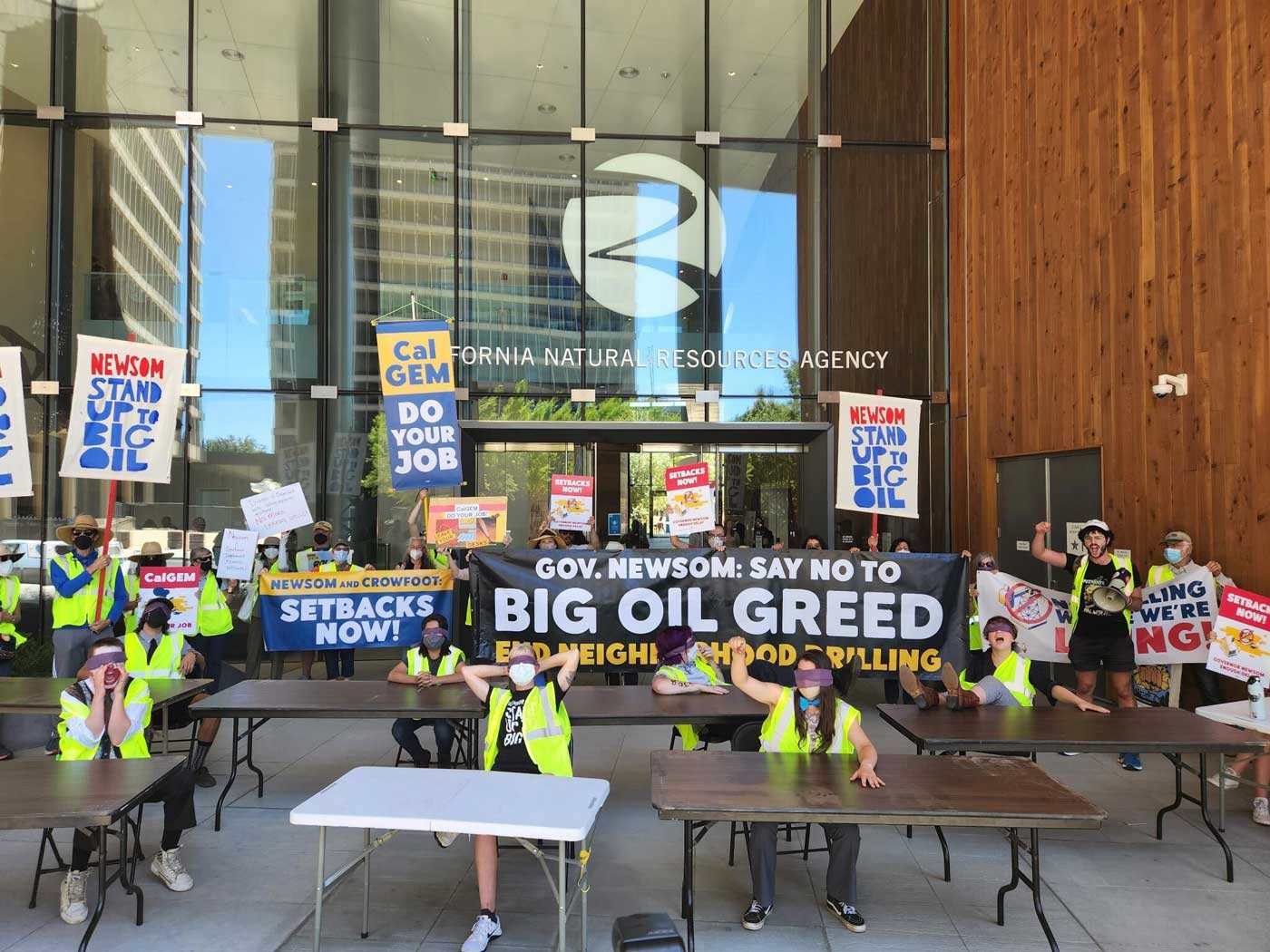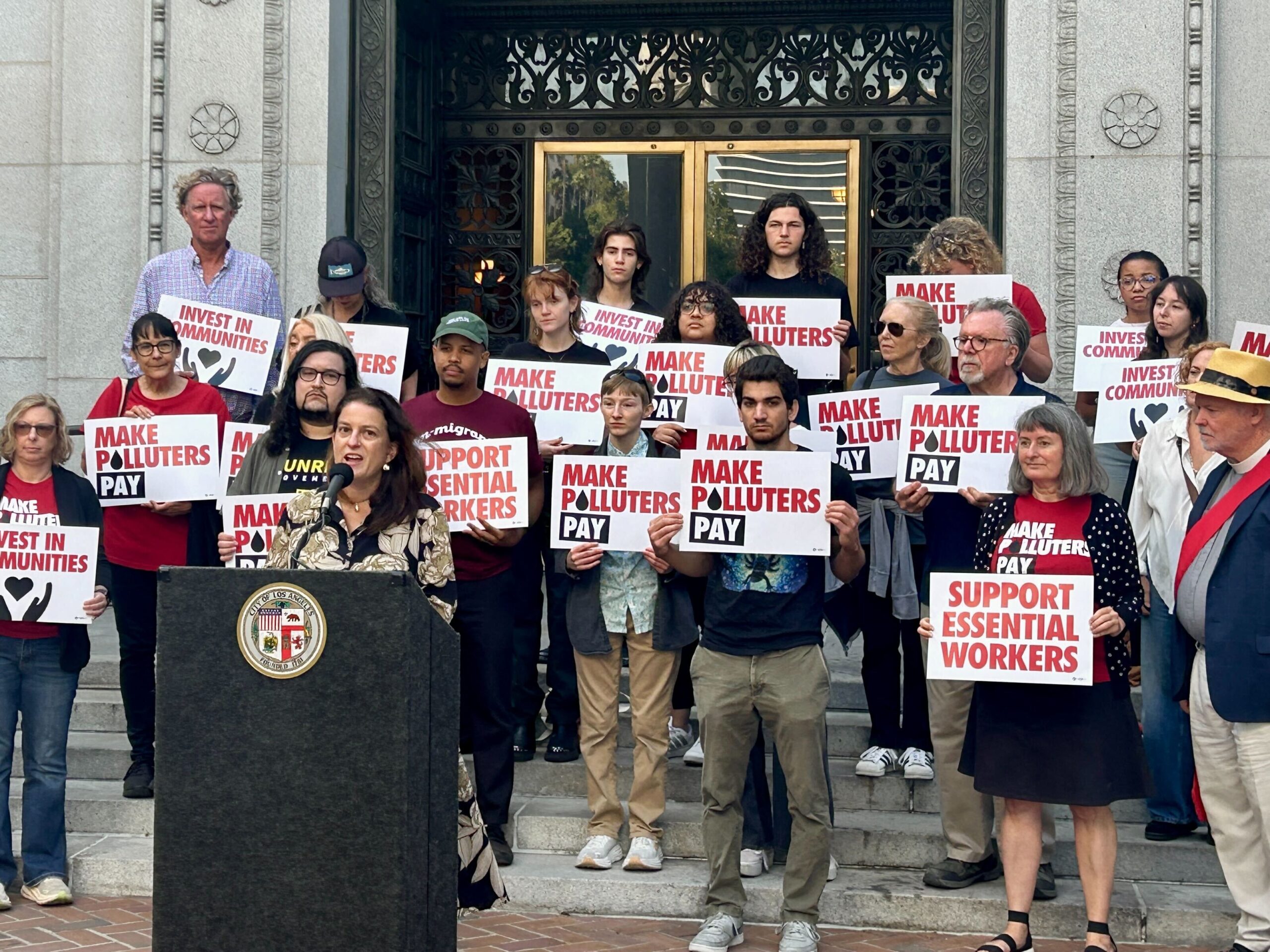SACRAMENTO, CA – Residents living on the frontlines of California’s oil extraction, and allies from across the state, came together today for demonstrations at the headquarters and Central Valley field office of the state’s oil regulator California’s Geologic Energy Management Division (CalGEM.) Advocates protested egregious mishandling of oil site inspections, threats to frontline communities from ongoing methane leaks at idle wells, and the long-delayed health and safety rule which Gov. Newsom touted last October would prevent new oil drilling in neighborhoods. Climate justice advocates and residents who have been sickened by oil drilling pollution gathered outside CalGEM’s offices to disrupt business as usual and bring their demands directly to the agency’s leadership.
“The Governor and Natural Resources Secretary Wade Crowfoot like to claim that they’re climate champions, but the reality couldn’t be further from the truth,” said Cesar Aguirre, a Kern County organizer with Central California Environmental Justice Network. “Their proposed health and safety rule is yet again stalled in a failed agency that won’t even go into the field to monitor the state’s riskiest and oldest oil infrastructure in-person. It’s clear that they are willing to ignore this public health emergency. Our communities are done waiting. CalGEM needs to do their job.”
In the last few weeks, over 40 oil wells were found gushing methane as close as 100 yards from homes in North Bakersfield. Whistleblowers have told the press that Uduak-Joe Ntuk, the state’s top oil regulator, was “lying” about the severity of the threats posed by the leaking wells and also that, “it’s a tragedy. Oversight integrity has gone sideways.” It’s unclear how long these oil wells, all of which are located next to homes, schools and houses of worship, have been spewing methane–calling into question CalGEM’s ability to carry out its stated mission. At least eight of the 43 wells are still not capped today.
An anonymous staffer also admitted to the media that the agency has placed a quota on the amount of wells staff must inspect through “remote witnessing,” a process that allows regulators to avoid in-person inspections of aging oil wells and instead monitor these sites from behind their desks. The Desert Sun reported that a CalGEM employee said these snapshot inspections, which rely on oil operators and third parties to send information from oil sites, are merely an effort to: “drive up numbers on a bar chart and make management look good.”
In Sacramento, dozens of activists placed props, including wooden oil derricks and desks, near the entrance to the CA Department of Conservation headquarters to represent the agency’s negligent process of remote desk monitoring. They carried signs and banners, making remarks through megaphones to demand that Secretary Crowfoot immediately enact a comprehensive 3,200 foot health and safety setback separating all oil extraction sites from neighborhoods – a decade-long delayed rulemaking process that the agency has been dragging its feet to continue.
Download Photos & Videos from Sacramento
“Here we have the state agency supposedly tasked with regulating oil and gas in California completely failing at their job. If California protected frontline neighborhoods with a robust setback rule in the first place, then these wells spewing methane would be far away from our homes and schools where they belong. This is on Newsom and on Crowfoot to fix immediately,” said Kobi Naseck of VISION, a coalition of frontline community and environmental justice groups.
In Bakersfield, community members stood outside the entrance to the Inland field office with banners that called out employees for skimping on critical public health and safety monitoring of oilfields and failing to conduct onsite inspection of thousands of wells over the past two years.
Download Photos & Videos from Bakersfield
“Our communities are tired of being neglected by our leaders and paying the public health and environmental price for it,” said Sierra Club Senior Campaign Representative Jasmine Vazin. “We’ve felt the consequences of their inaction as dangerous amounts of methane spew into the air near Bakersfield homes, schools, and a day care center. But these leaking wells are merely the tip of the iceberg that is California’s idle and orphan well problem. We stand beside the community members demanding Governor Newsom put their public safety first and foremost and address the toxic drilling activities that are going on in our backyards.”
CalGEM has a long history of regulatory negligence, from outdated policies and missing paperwork that allowed oil companies to avoid environmental review, to rubber stamping risky projects by using so-called “dummy” folders. Key staff at the agency have also held personal investments in the very companies they were charged with regulating. In 2019, Gov. Newsom vowed to reform the infamous agency with a staffing shake up and new mission focused on public health safety and environmental quality. Since then, little has changed.
“Now yet another scandal shows us that state oil regulators are still not doing their job to protect Californians. An agency name change and new supervisor have not changed a thing. CalGEM needs new leadership from someone with a genuine commitment to environmental justice and robust regulation,” said Shosana Wechsler, coordinator with Sunflower Alliance.
It was not CalGEM but local organizers with environmental justice groups who knocked on neighbors’ doors to warn them about the wells spewing dangerous concentrations of methane and likely other volatile organic compounds since mid-May. They found that neighbors were already suffering from unexplained headaches, fatigue and stomach aches.
“Pollution from oil and gas operations causes asthma and other breathing problems, may cause cognitive decline and cancer; it affects babies even before they are born,” said Marjaneh Moini, board member, Physicians for Social Responsibility. “We must phase out oil and gas infrastructure to truly protect public health, that is exactly what CalGEM scientific advisory panel has recommended. A 3200 foot buffer between Californians and industrial oil operations is the bare minimum to protect their health, their livelihoods and their families.”
While the Governor’s office said in a statement that, “state has taken urgent action to ensure these wells are properly remediated and operators are held accountable,” the agency admitted last Friday that five previously repaired wells were leaking again and they discovered two new wells spewing methane. There are thousands of such idle or abandoned wells across the state – with as many as two-thirds leaking methane – putting frontline communities’ health at risk and potentially leaving taxpayers saddled with cleanup. Frontline communities are calling for the state to mandate 3,200 feet separating neighborhoods from new and existing oil infrastructure.
“Gov. Newsom claims that California’s efforts to cut methane pollution are ‘world-leading’ — but CalGEM’s unacceptable behavior is the opposite of global leadership,” said Collin Rees, United States Program Manager at Oil Change International. “Real leadership means aggressively enforcing public health regulations and implementing real setbacks to protect communities from the impacts of oil and gas extraction. That’s Newsom and CalGEM’s job, and right now their empty claims are falling flat without real action.”
###




